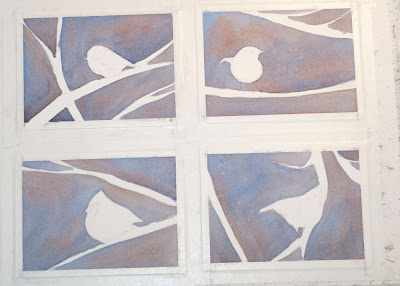It's been a loooong time since I posted
anything here on my blog. Ok, almost three years. But a lot of people ask me why I stopped blogging, and tell me that I've helped them, so I'm going to try to get back into the habit. Here is something that I find really
useful and I decided to share.
The
more you know about the watercolors on your palette, the better. If you
have all of their properties in your head, you can make much faster and
better decisions as to how to use them. And it's fun to play with them
anyway, so that's a bonus. Watercolor paints are made of pigments
suspended in a water-based solution, and the various pigments have
different qualities. The most obvious variation is the color, or hue,
but there are other variations, such as transparency, permanence, and
value. Knowing how to expect your pigments to behave is a crucial step
in learning to create better watercolor paintings.

To
create my guide, I started by cutting out a long, thin piece of
watercolor paper. Mine is about 3 x 7 inches, but the length of yours
will depend on how many different colors you intend to test. If you're
not sure, you can just cut more paper than you need, and trim off the
excess later. Next, I drew a thick vertical line with a black sharpie
about 1/4 of the way over from the left edge of the paper. This line
will help you learn about the transparency of your watercolor pigments.
The
next step is to mix small puddles of your chosen colors. Each of your
puddles (or washes) should be about the same consistency. You don't want
any of them to be significantly thicker or thinner than the others. You
can mix them one-by-one or all at once, just as long as they are pretty
consistent. Dip one of your smaller brushes into the first puddle, and
carefully paint a steady line of color across the black line. Make the
lines of color long enough to be able to create another vertical line to
the right of the black one (you'll find out why in a minute). Continue
this process with each of your colors, making sure to thoroughly rinse
your brush after each stroke. I chose to go in order of colors because
it makes it so much easier for me to compare similar hues. As you go,
label your colors with a fine-tipped pen, so you don't forget what any
of them are. Once you have painted all of your colorful lines, let them
air dry. (You may use a hairdryer to speed things up.)
For
the final step, take a stiff-bristled brush, get it good and wet (not
dripping), and use it to scrub away some of the paint. Start at the top,
and make a vertical "scrubbing" line all the way to the bottom. Try to
use the same amount of pressure and scrubbing all the way down the
paper, so you don't end up with some colors that were scrubbed more than
others. When you get down to the bottom, use a tissue or dry paper
towel to blot up the water and lifted paint. Any old brush with stiff
hair will work for this step, as long as you don't mind abusing it. I
like to use the Fritch Scrubber brushes made by Cheap Joe's Art Stuff
(no paid affiliation, but they are an awesome company; their owner, Joe,
is a true friend to artists everywhere). They sell a few different
sizes and I use them in my own paintings all the time. The scrubbing
teaches you about the permanence of your pigments. As you can see in
Example A., some of the colors will readily disappear, while others are
certain that they are here to stay.
At
this point you will have a reference guide that will tell you a lot
about your watercolors. However, I decided to go one step further. I
made a black and white copy of my chart (Example B). What is the
purpose? Well, it helps me see the inherent differences in value that
each of the colors have. As you probably know, you can make your colors
darker or lighter in value by adding less or more water to the paints,
but some colors are simply lighter or darker than others. A good example
is yellow, which, by itself, will never be able to be a dark value.
Ever
since I made my own guide, I find that I use it all the time. No matter
how well I think I know my paints, it's great to have all of the
information right there in front of me when making important painting
decisions. I've pinned both pieces of paper right on my studio wall for
easy reference.
Thanks for reading! If you found this article useful, please comment, follow and/or check out my other posts!
Laura
























